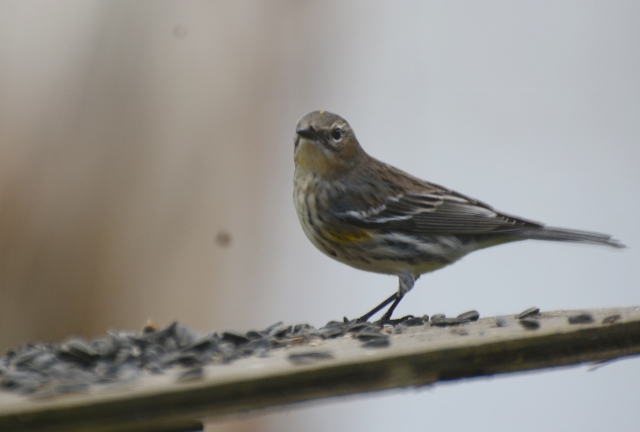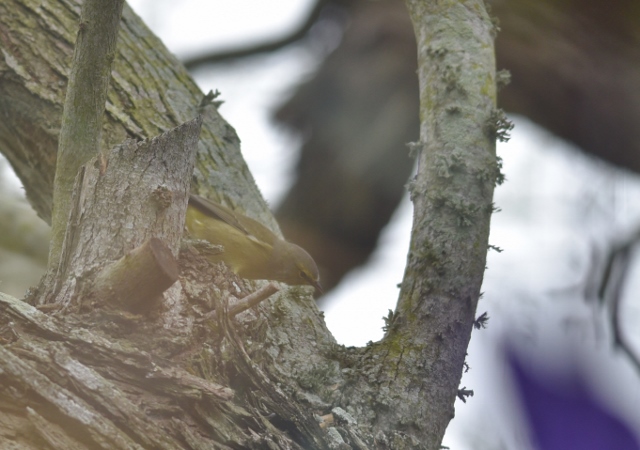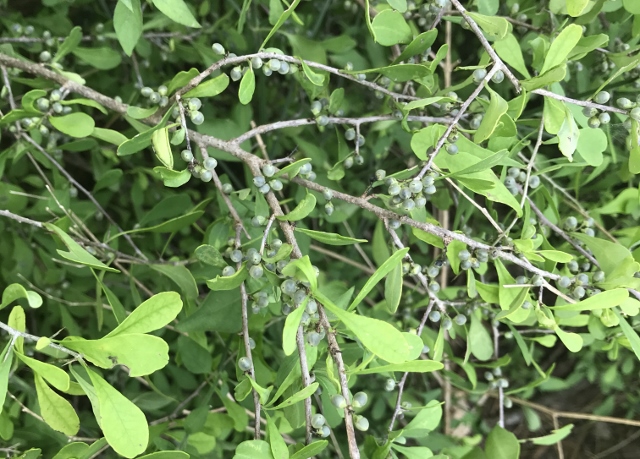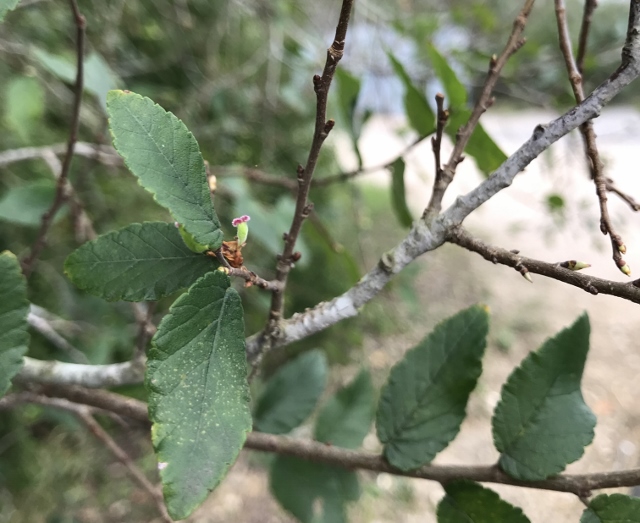and Sidebar — Three Valley native plants attract wintering-over warblers
Stories and photos by Anita Westervelt, Texas Master Naturalist

They’re tiny, they’re quick, they’re wily. They’re warblers — certainly the thrill of spring and fall migration — and lucky is the Valley yard where some species choose to spend the winter.
Warblers are skittish. They dart through crisscross branches in the canopy of a tree, snagging insects. They hardly perch for any length of time before jetting off, performing aerial feats, busily feeding through the daylight hours.
Warblers are some of the smallest birds found on the North American continent, typically known for their long migrations from South America and the West Indies to northern Canada and back. Their sizes range from about 4.25 to 5.75 inches in length.
Yellow-rumped warblers are probably the most prevalent species to winter in the Rio Grande Valley. Their name gives them away. Spend time watching this little bird and you’ll see sporadic flashes of yellow. The most prominent patch is just above their tail feathers.

During winter, yellow-rumped warblers are likely to be in areas with fruiting shrubs and trees. In addition to insects, seeds and berries, they will drink juice from fallen oranges and tree sap.
Orange-crowned warblers winter farther north than most other warblers. They are tiny, thin, and look like a dark, olive-green peapod, except for a sharp, pointed beak and hint of yellow under the tail. The orange crown is rarely visible unless the bird is agitated.

These busy birds forage low in shrubs and then flit rapidly to tree tops. They navigate vine tangles and other vegetation, picking insects from leaves and buds. Their diet includes ants, beetles, spiders, flies, and caterpillars. In winter, they eat fruit, berries, seeds, and plant galls. They also will pierce the base of flowers to get at the nectar and sometimes visit hummingbird feeders.
Yellow-throated warblers might choose to stay in the Valley for the winter, too, although they also migrate to the West Indies, Mexico and Central America. They frequent palm trees in some of their winter range.

This warbler has a different foraging habit than the quick, erratic movements of most warblers. The yellow-throated warbler creeps along inner branches, twigs and in the foliage, generally in the upper parts of trees. They pick insects from the bark and bark crevices.
The yellow-throated warbler’s foraging habits and markings are similar to the black-and-white warbler — another warbler that may choose to winter in the Valley. Black-and-white warblers are pickers and probers. They eat insects and spiders, and insect larvae and egg masses, which means they don’t have to wait until an insect emerges in order to find food — a trait that allows them to be one of the first spring migratory warblers to pass through the Valley.
To attract warblers to your yard in the winter, several birding websites recommend putting out sunflower seeds, raisins or suet, or a suet and peanut butter mix.
Sidebar
Three Valley native plants attract wintering-over warblers
Story and photos by Anita Westervelt
Three native Valley plants that produce berries noted to attract wintering warblers are snake eyes (Phaulothamnus spinescens), cedar elm (Ulmus crassifolia) and coma (Sideroxylon celastrinum).
Snake eyes is a fun shrub. In the fall, it will be draped with masses of translucent berries close to the stems. Each berry contains one round black seed — hence the name of this interesting shrub.

Snake eyes is unique in another way. It is dioecious, which means the tiny, greenish male and female flowers are on separate plants. The flowers bloom spring and summer. Without a male plant nearby, the female plant will not produce berries — plant two or three shrubs to get the fall show. This dense shrub is good cover for several species of birds.
Snake eyes is rather rare, although native to south Texas and into Mexico. It is more likely to be found in bushy thickets of the Rio Grande Valley. It can grow as tall as 10 feet or more and span six to eight feet in width. It likes full sun and tolerates clay soils.
Without fruit, a snake eyes shrub can be hard to identify. The leaves are small, about 1 and 3/8 inches long. They are gray-green in appearance and somewhat shaped like fat exclamation points! The leaf shape is considered to be spatulate. The delicate soft leaves belie the sharp spines hidden on the branches.
Cedar elm has the tiniest blooms imaginable for a tree. The tree can grow to 50 to 70 feet. Growth rate is considered moderate. The leaves are oval, grow alternate along the branches and have prominent veins and toothed edges.

The tree blooms in summer and has winter fruit. It is usually found in moist places in the Valley, on the banks of resacas, ponds or along the Arroyo Colorado in well-drained soil, although it has high drought tolerance.
Coma is a small, slight tree that can push up new trees from root sprouts, forming a comal — pronounced co-mall. It may eventually grow to 30 feet tall, but usually is much less.
Coma blooms fragrant clusters of white flowers spring, summer and fall from the leaf axil. The flowers turn into drupes — a fleshy fruit with a “stone” that usually surrounds a single seed — the drupes turn black when ripe.
The tree has long slender thorns on the side branches. A coma tree can be identified by its leaves. The center leaf vein is curved like a punctuation comma in the more mature leaves. Other clues: the leaves feel leathery and mature leaves snap a clean break when folded.
Harlingen’s Hugh Ramsey Nature Park has examples of these three species. Free guided native plant walks are first Friday and third Saturday through May. Meet in the parking lot at 9 a.m. for a two-hour stroll. The park is at 1000 South 499, two miles south of Harlingen’s Valley International Airport or just north of the Arroyo Colorado River Bridge on Ed Carey Drive.
“Smithsonian Handbooks Birds of Texas” (Alsop III, 2002) and “Plants of Deep South Texas” (Richardson and King, 2011) were helpful in writing this article. There are many online websites about birds including tpwd.texas.gov, birdsna.org, allaboutbirds.org, audubon.org, birdsforever.com, birds.cornell.edu, birdweb.org, biokids.umich.edu and feederwatch.org.
